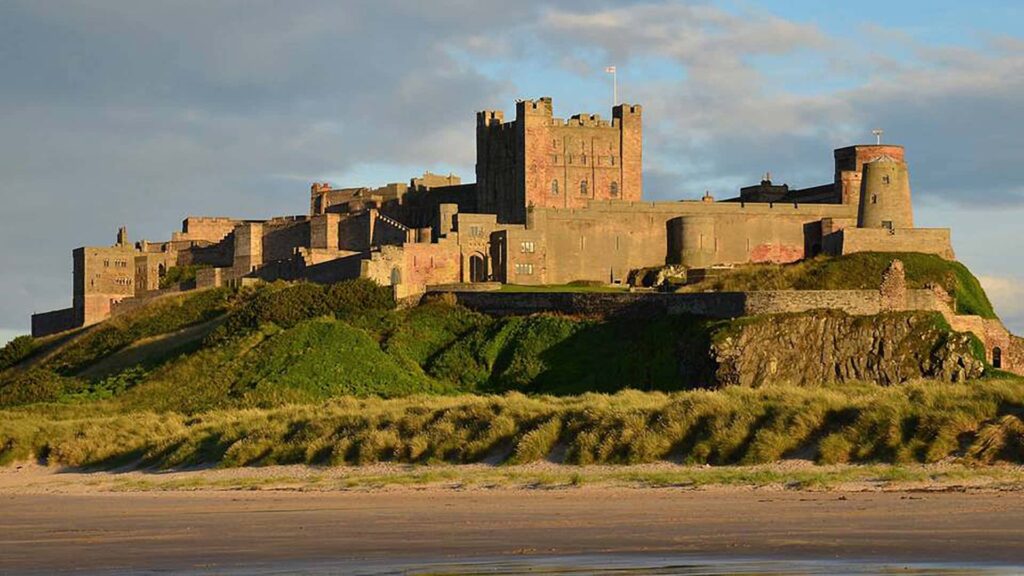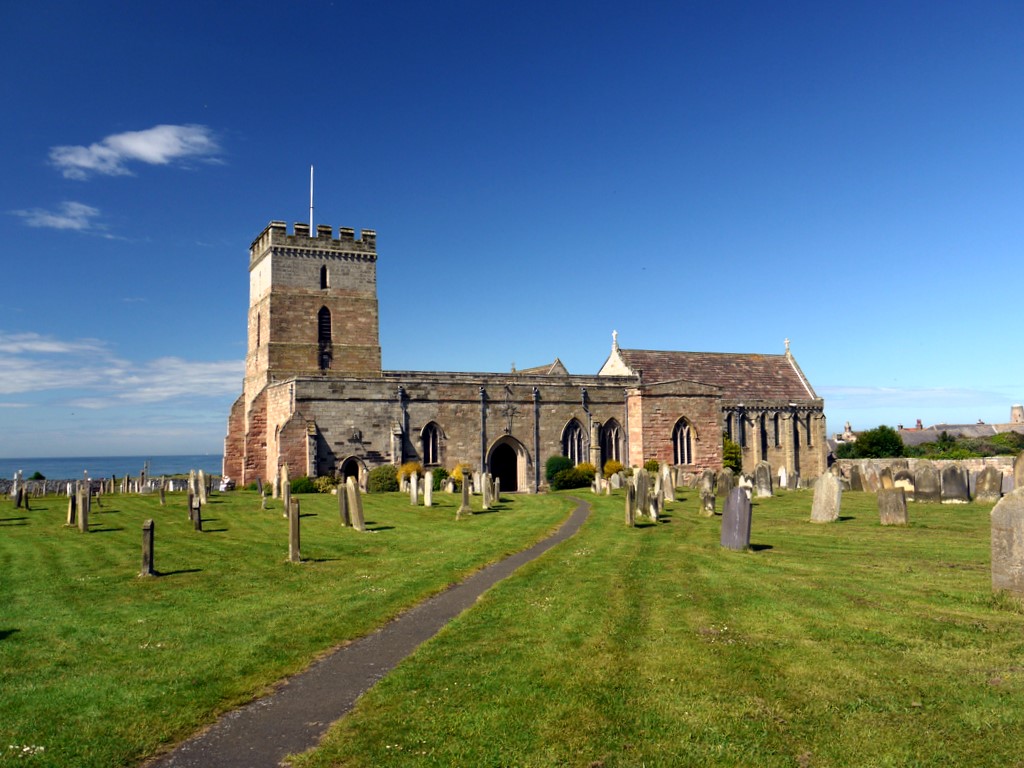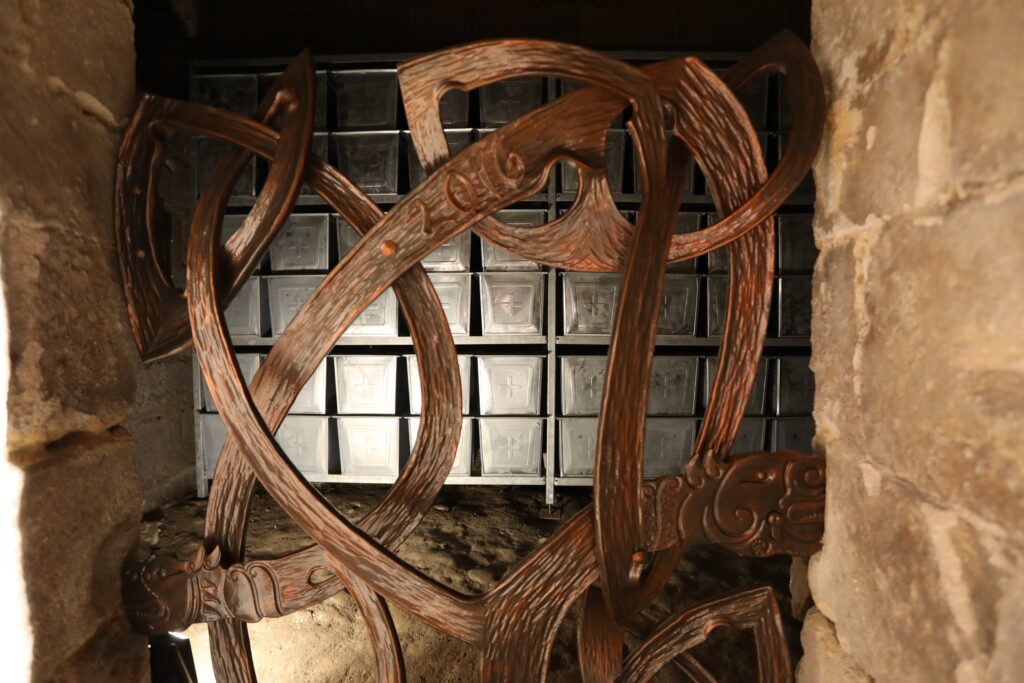In this week’s blog, I’m recounting when I was at St Aidan’s Church in the village of Bamburgh. I chated with Jessica, project manager of The Bamburgh Bones about the project which brings the Anglo-Saxon history of Northumbria alive.

Northumbria was a kingdom founded in the 6th and 7th centuries AD by Anglo-Saxon warlords who arrived from the continent under the leadership of a man called Ida who a war leader of the Angles. Ida, a semi-mythological character, arrived at Bamburgh and conquered Lindisfarne and Bamburgh. In the following years, his descendants continued to conquer parts of southern Scotland, the modern-day Northumberland, County Durham and North Yorkshire. They also subjugated kingdoms across the rest of Britain.
My question to Jessica was – what is the Bamburgh Bones Project?

Photo © Andrew Curtis (cc-by-sa/2.0)
It is an interpretation of the amazing Anglo-Saxon heritage of Bamburgh. It came about because of the Bamburgh Heritage Trust – a small community of volunteers – who liked to do some interpretations of the heritage. We have a rich heritage here with the Grace Darling museum and the castle but not much was being said about the Anglo-Saxon heritage of the town.
The group’s ambition was to find a place and a location to tell that story. Someone suggested the crypt in the church might be a good space. The crypt had been closed to the public for 30 years because of difficulties with access. But the Heritage Trust came to look around and decided it was an incredible space.
At the same time, the Trust was chatting to the Castle about some skeletons which had been excavated from an area south of the Castle between 1999-2007. The excavation licence from the Home Office stated that the bones must be reburied after the excavation. That was back in 2016.
We know so much about those skeletons because so much research was done around them. They belonged to the Anglo-Saxon community that lived in and around Bamburgh during the 6th, 7th and 8th centuries. They are a very special group of people and deserve something special to be done with their remains. So we created an ossuary in the small second crypt in the Church. The skeletons were placed into boxes and placed behind a beautiful, commissioned grill in the crypt.

What we know about the skeletons
While archaeology is a very young science, we have been able to find out a lot about the skeletons of Bamburgh thanks to archaeology. We now have a much better understanding of isotopes. Jessica, tell us a little more about that.
The bowl hole was known about and was marked on the first edition OS map as an old Danish burial ground that we thought was Vikings. But when we excavated and found east-to-west aligned burial sites we knew it was Christian so that moved our understanding along. Then we started working with Durham University to do isotope analysis. The enamel in our teeth holds a mineral trace of the environment in which those teeth grew. That means we can tell where somebody comes from. Where they grew up, where they lived, and where they spent their life.
Those isotopes produced an amazing map of the population as they came here from all over the world. Less than 10% of the skeletons excavated come from the immediate area. The rest were from much further away, particularly Ireland and the Scottish islands and highlands. There were also people from Scandinavia, possibly from Italy and Spain.
One of the skeletons, a ten-year-old child, had a mouth erupting with teeth. With this skeleton, we had two hits on the isotopes because we could analyse the baby teeth which form in the uterus, which tells us where the mother came from, and the adult teeth which form in early childhood. The baby teeth suggested the mother was from somewhere incredibly hot like Southern Spain or North Africa and the adult teeth, she was still somewhere like the south of France. This shows that over the course of ten years, the mother has migrated over two continents to end up in Bamburgh.
So the people from continental Europe have been drawn here to the capital city of Northumbria which had, at the time, just converted to Christianity under King Oswald and his dear friend and Irish missionary, St Aidan. What’s your view on Oswald and Aidan?

It’s all linked. We know the cemetery dates from 650 to about 800 AD so incredibly important from an archaeological point of view. We know that Oswald returns to Northumbria to create the Kingdom in 634 and he calls to Iona to come and convert the pagan Northumbrians to Christianity and that’s when Aidan comes. Aidan arrived in 635 and founded his first church here, on this very site.
We can then link that story to our archaeological story of the Bamburgh Bones. Sometimes stories from that time are quite ephemeral because they happened so many years ago. But these people were Aidan’s congregation. They heard him preach in this church so it is incredibly appropriate that their final resting place is right here. There is one skeleton in there who was around 50 years old when he died. He dates to around 650 and his isotopes suggest that he comes from the Iona region – a direct contemporary of St Aidan and Oswald who was exiled to Iona at the age of 13 when this boy would have been the same age.

We’ve also got one of the ossuary boxes – could you tell us a little bit about that too?
Ossuary boxes were used in continental Europe and, in fact, many European and South American countries still practise charnel – a very sensible way to deal with overcrowding in cemeteries. In some cultures, you rent a burial space but at the end of 30 years, you move the remains of your ancestor into a charnel box because it’s a much more compact way of storing the deceased. Charnel boxes can’t be bought in this country so we had to get the boxes from Italy. They need to be big enough to take the length of the femur and the bulk of the skull. Everything else just fits in around it.
So, every person excavated from the bowl hole cemetery has an individual box and has been gently laid to rest in the crypt, connecting them back to the Anglo-Saxon, Dark Age community they were part of back then. That’s special.
It’s a very special place. The crypt itself is beautiful. We are stood in a 12th/13th-century chancel and it’s wonderful to have created this space so that everyone can visit and see.
What is the best way to support The Bamburgh Bones project?
First of all visit the website at www.bamburghbones.org where you can see a digital ossuary. You can see the evidence and codenames of every single skeleton. We’re also looking for supporters to adopt a box. That would help us to sustain the building and the equipment we use.
If you are also interested in the isotopic information from the excavation you can read it here: Mobility histories of 7th–9th century AD people buried at early medieval Bamburgh, Northumberland, England https://onlinelibrary.wiley.com/doi/10.1002/ajpa.22290



